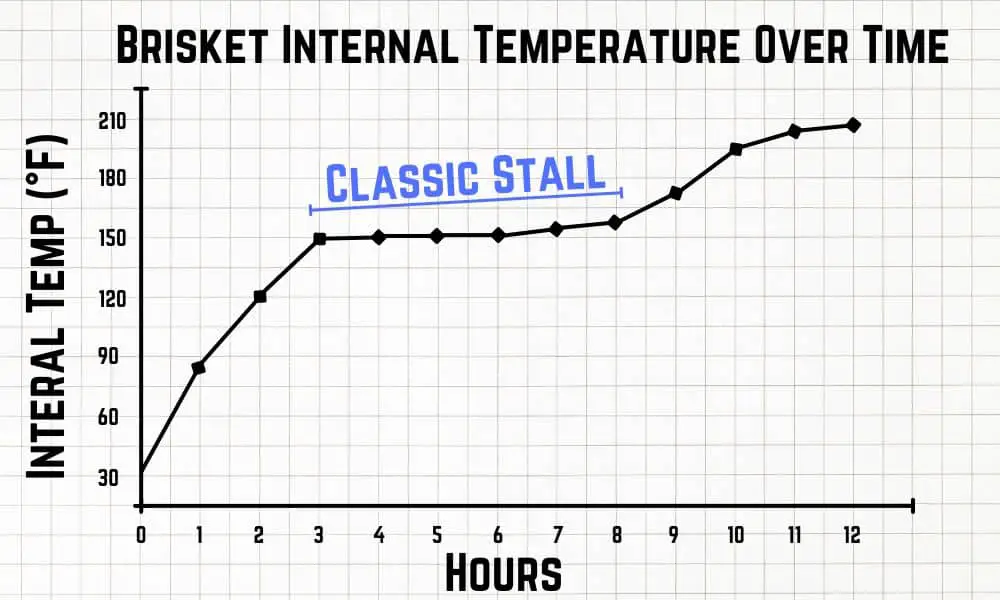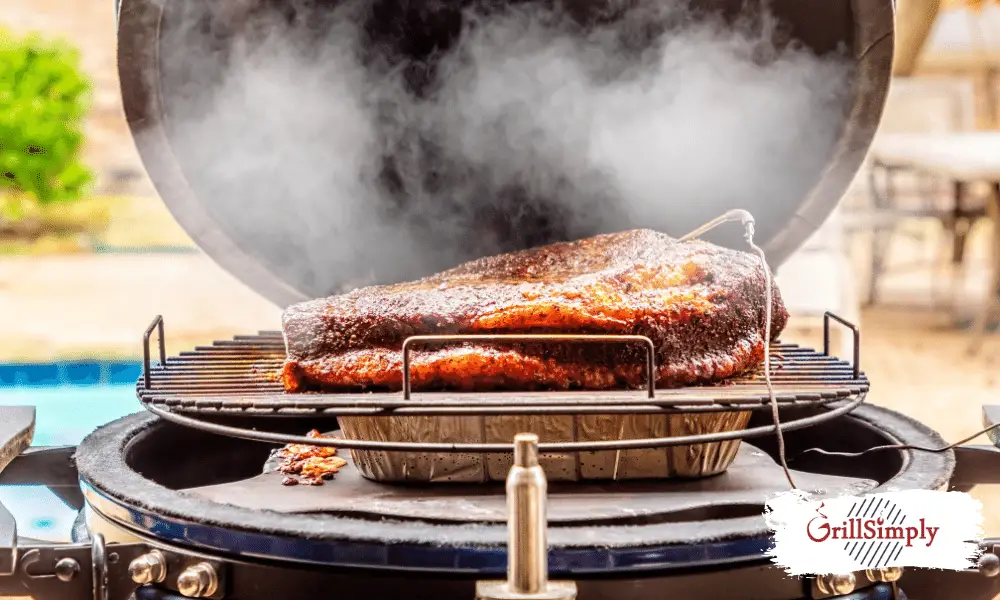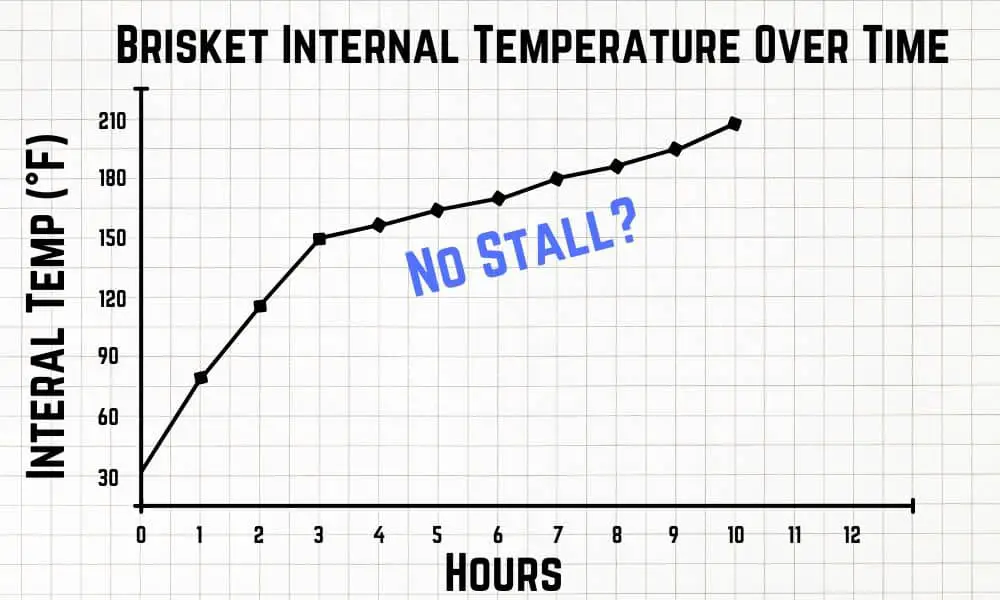It’s no secret that smoking brisket is normally an all-day job. But I think we can all agree it’s worth the wait!
One of the leading reasons brisket takes so long is due to the infamous but very important “stall”, the mysterious internal temperature plateau around 155-165°F.
But what happens when you expect this stall to take place, but your brisket’s internal temperature goes barreling right through it?
Here we go through why the brisket stall is an important part of the cooking process, why a brisket may not have stalled, and what you can do to ensure it’s still cooked beautifully.

Anyone who has smoked their fair share of briskets will tell you all about the infamous and time-consuming brisket stall.
The stall is when the temperature of the brisket halts, sometimes for several hours without rising at all. Sometimes it even drops a few degrees!
This usually occurs around the internal temperature of 155-165°F, but can happen at different temperatures depending on the brisket and the conditions.
This phenomenon is actually caused by a combination of the brisket starting to sweat due to the rising temperatures, and the evaporative cooling effect on the exterior of the brisket. The result? A temporary temperature plateau.
But just because the temperature stops rising, doesn’t mean the brisket stops cooking.
During this stall, the connective tissue and fat continue to break down, and the bark continues to form.
So although it can be frustrating and time-consuming, it’s all part of the process.
What Temperature Brisket Normally Stalls At

The stall of the brisket isn’t necessarily linked to a specific internal temperature. Instead, the stall is merely the time when the sweating of the meat and the subsequent evaporation cooling cools the meat faster than it can heat up.
The timing of the stall depends on the overall size of the brisket, the fat and connective tissue content, your smoker, and what temperature you’re smoking it at.
In saying that, the normal stall of a brisket happens between the internal temperatures of 155-165°F.
However, it’s not uncommon to see an earlier stall, from 145°F-155, if you’re smoking a small brisket or when smoking at higher temperatures.
In the same way, you may see a longer or later onset of the stall, from 155-165°F, if you’re smoking a large packer brisket, or smoking at lower temperatures.
Brisket Didn’t Stall?

So with all this talking about stalling being a normal thing, how is it that it’s possible to smoke a brisket without it stalling at all?!
The simple answer?
If you don’t experience any temperature plateau or stall when you’re smoking brisket, it’s simply because the temperature was able to rise quicker than the evaporative cooling could cool the brisket.
The no-stall brisket most commonly occurs when:
- Smoking smaller briskets
- Smoking brisket at higher temperatures
- You’ve wrapped your brisket early
If your brisket didn’t stall and it’s done way sooner than you’d aimed for, check out this guide for what to do when your brisket’s done too early.
No Stall On Smaller Briskets
It’s much more common for a smaller-sized brisket to completely plow through the stall when smoking.
The same can be said if you’re just smoking just the point or just the flat (or deckle-off brisket).
This is because smaller briskets are able to heat up quicker than larger briskets.
If the rising temperatures of the brisket outweigh any reduction of temperature from the evaporative cooling on the surface of the brisket, then it simply won’t stall, or the effect will be much less dramatic.
This happens much more often on briskets weighing under around 5 pounds.
Smoking At Higher Temperatures
No matter what size brisket you’ve got, if you’re smoking it at too high of a temperature then it’s likely the heat will push right through the stall.
But even though this gets the job done quicker, it’s not actually a good thing. After all, briskets take significant time for all the connective tissue and fat to break down and become tender and juicy.
The ideal temperature for smoking brisket lies between 225-275°F (I prefer 250°F).
Smoking brisket at 300°F or more can lead to some tougher and drier briskets!
Wrapping Too Early
Humidity plays a huge part in the smoking process. If the smoking environment is too humid, i.e. there is too much moisture available, then there will be much less evaporative cooling of the meat.
As soon as you wrap your brisket in foil or butcher’s paper it immediately makes the environment super humid.
This prevents evaporative cooling, which in turn puts a stop to the typical stalling process.
If you are going to wrap your brisket it’s best to only do so after you are satisfied with the bark development, and the internal temperature hits at least 160°F.
You can wrap your brisket all through that stall until it’s completely done at 200-205°F and probes like butter!
It also helps to use top-quality butcher’s paper as it’s more breathable than foil or lower-quality butcher’s paper.
Is It Bad If A Brisket Doesn’t Stall?

Although the stall of a briskets tests the patience of some of us, it’s actually a very beneficial part of the process.
That is because although the temperature stops rising, the brisket continues to cook over these hours.
The stall actually allows adequate time for all the connective tissue to properly break down. After all, a brisket cooked too fast often comes out tougher – that’s the whole reason for low and slow smoking!
What’s more, the longer the meat is exposed to the smoke, the more smokiness the meat will absorb. Without adequate smoking time, your brisket is likely to come out with no smoke ring!
Lastly, this constant sweating and cooling, the smoke, and the melting of fat all help build an incredible bark on your brisket.
This is especially true if you’re spritzing the brisket over this time to add additional layers of flavor and to keep things moist.
Although you experience amazing results, tenderness, and flavor from a brisket that didn’t experience a temperature plateau, the stall is considered to be beneficial to the process.
What You Can Do If Your Brisket Didn’t Stall
Whether you’re dealing with a small-sized brisket, you’ve smoked your brisket at higher temperatures, or you wrapped your brisket to early, here’s what you can do if your brisket didn’t stall whatsoever.
Firstly, you don’t need to stop cooking your brisket until you are happy with the texture. Ignore what the internal temperature reads on your thermometers and keep cooking that bad boy until it probes like butter.
Some briskets will be ridiculously tender and juicy at 197°F, some you can take all the way up to 210°F before it becomes as tender.
The second step is to adequately rest your brisket. Stall or no-stall, a brisket should rest for one to four hours so it can settle and the moisture can redistribute and reabsorb into the meat.
There’s not a lot you can do to develop the bark, smokiness, or smoke ring at this point, but these steps will ensure it’s still cooked brilliantly.
Conclusion
Although being patient can sometimes feel excruciating, the stall of a brisket is a beneficial part of the smoking process. It allows enough time for the fat and connective tissue to break down properly.
If your brisket didn’t stall at all, don’t worry. It’s relatively common if you’re smoking smaller briskets, smoking at higher temperatures, or the humidity is too high, like when you wrap your brisket too early.
No matter the reason, if you continue to cook your brisket until it probes like butter, I guarantee no one is going to be complaining!

